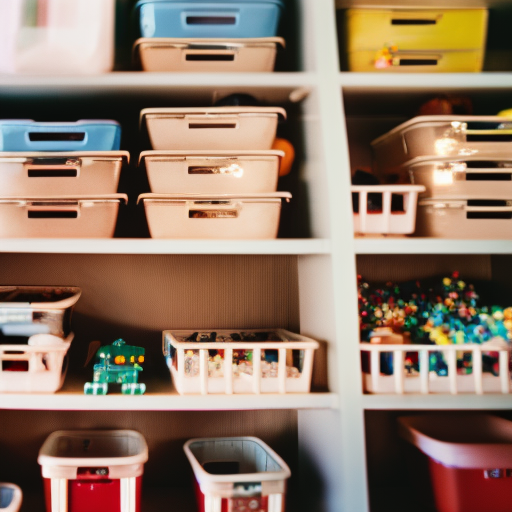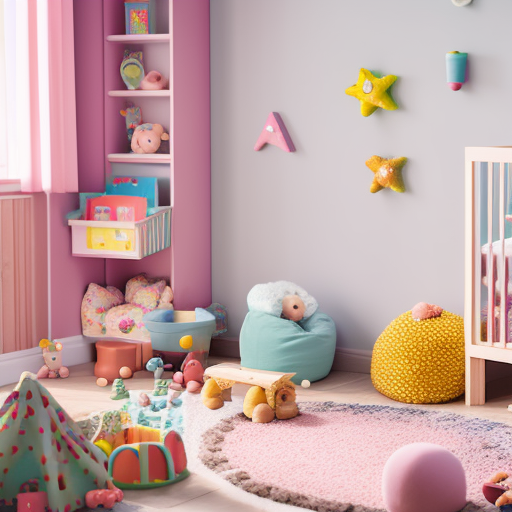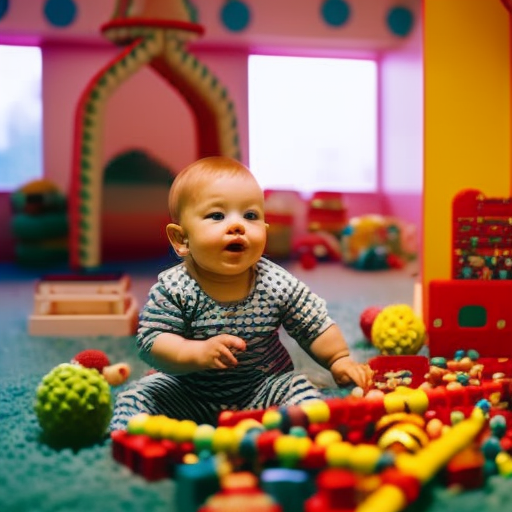"Cherishing Little Steps - A Haven for Baby and Family Journeys"
ADHD Parenting for Babies
Are you a parent of a baby with ADHD? Do you desire to serve your child with the best care and support?
Welcome to ‘ADHD Parenting for Babies,’ where we will provide you with practical guidance to navigate the unique challenges of parenting a baby with ADHD. Understanding ADHD in babies is the first step towards creating a nurturing environment.
By establishing a structured routine and creating a supportive atmosphere, you can help your baby thrive. We will also address sleep and bedtime challenges, promote sensory engagement, and implement positive discipline strategies.
Encouraging social interaction, addressing feeding and nutrition concerns, and seeking professional support and resources will further empower you in your parenting journey. Let’s embark on this journey together and make a positive difference in your baby’s life.
Understanding ADHD in Babies

To better navigate ADHD parenting for babies, it’s important for you to understand how ADHD can manifest in infants. While it isn’t possible to diagnose ADHD in babies, there are early signs that may indicate a potential risk for developing ADHD later in life. Research suggests that babies who are more fidgety, have difficulty settling down, and struggle with sleep patterns may be at higher risk. Additionally, babies who’ve difficulty with self-regulation, such as managing their emotions or inhibiting impulsive behaviors, may also exhibit early signs of ADHD.
It is important to note that these early signs aren’t definitive indicators of ADHD, as many babies exhibit some of these behaviors as part of normal development. However, if you notice a persistent pattern of these behaviors that’s significantly different from other babies of the same age, it may be worth discussing with your pediatrician.
Understanding developmental milestones is also crucial in identifying potential ADHD symptoms in babies. Developmental delays, such as delays in reaching motor or language milestones, may be associated with ADHD. However, it’s essential to remember that not all babies who experience developmental delays will develop ADHD.
Establishing a Structured Routine

Start by creating a consistent and predictable daily schedule for your baby. Establishing a structured routine is essential for babies with ADHD, as it provides them with stability and helps them develop a sense of security. Here are some tips to help you establish a routine that works for both you and your baby:
-
Set a consistent wake-up time and bedtime for your baby. This will help regulate their sleep patterns and ensure they get enough rest.
-
Plan regular mealtimes and snack times throughout the day. This will help regulate their appetite and prevent them from becoming overly hungry or full.
-
Incorporate regular playtime and physical activity into their daily schedule. This can include activities such as tummy time, crawling, and exploring their surroundings.
-
Create a structured environment by organizing their toys and belongings. This will help minimize distractions and promote focus.
-
Stick to the schedule as much as possible, but also be flexible and adaptable when necessary. Babies with ADHD may have unpredictable moments, so it’s important to remain patient and understanding.
By establishing a consistent routine, you’re providing a structured and predictable environment for your baby. This can help reduce their ADHD symptoms and create a sense of calm and stability in their daily life.
Remember to be patient and understanding as you navigate this journey with your baby.
Creating a Supportive Environment

Establishing a supportive environment is crucial for helping your baby with ADHD thrive. Babies with ADHD often struggle with sensory overload and can become easily overwhelmed. Creating a calming space in your home can help reduce their stress levels and promote a sense of security. Consider using soft lighting, soothing colors, and comfortable furniture to create a peaceful atmosphere. Limiting noise and distractions can also be helpful.
In addition to creating a calming space, providing consistent routines is essential for babies with ADHD. Establishing a predictable schedule can help them feel more secure and reduce anxiety. Try to maintain consistent meal times, nap times, and bedtimes. Use visual cues, such as a visual schedule or picture charts, to help your baby understand and anticipate daily routines.
Research has shown that a supportive environment can significantly impact the well-being of babies with ADHD. By creating a calming space and providing consistent routines, you’re setting the stage for your baby’s success. Remember to be patient and understanding as you navigate this journey together. With your love and support, your baby can thrive and reach their full potential.
Managing Sleep and Bedtime Challenges

Creating a calming bedtime routine can help you manage sleep and bedtime challenges for your baby with ADHD. Sleep training and establishing a consistent bedtime routine are crucial for ensuring that your little one gets the rest they need. Here are some tips to help you navigate this challenge:
-
Create a soothing environment
-
Dim the lights and eliminate any distractions in the bedroom.
-
Use white noise machines or soft lullabies to create a peaceful atmosphere.
-
Establish a consistent routine
-
Choose a regular bedtime and stick to it every night.
-
Develop a series of calming activities before bed, such as a warm bath or gentle massage.
-
Incorporate quiet activities like reading a book or singing a lullaby to signal that it’s time to wind down.
Research has shown that a consistent bedtime routine can help regulate your baby’s internal clock and promote better sleep. By following these strategies, you can create a peaceful and predictable environment that supports healthy sleep habits for your baby with ADHD.
Promoting Sensory Engagement

To promote your baby’s sensory engagement, incorporate stimulating activities into their daily routine. Sensory exploration plays a crucial role in your baby’s development, as it helps them make sense of the world around them. By providing a variety of sensory experiences, you can support their cognitive, emotional, and physical growth.
Creating stimulating environments at home is essential. Make sure your baby has access to different textures, colors, and sounds. Soft blankets, toys with various textures, and musical instruments can all contribute to their sensory development. Engage your baby in activities that encourage them to touch, listen, and observe. For example, you can play with water in a shallow basin, allowing them to feel the different temperatures and textures. Sing songs, read books with vivid illustrations, and expose them to different types of music.
Outdoor playtime is another opportunity for sensory exploration. Take your baby to the park or a natural setting where they can experience different sights, sounds, and smells. Let them touch leaves, feel the grass under their feet, and listen to the sounds of nature. These experiences not only stimulate their senses but also provide a calming effect.
Nurturing Emotional Regulation

To nurture your baby’s emotional regulation, provide consistent and responsive care to support their emotional well-being. Developing self-soothing skills and fostering emotional resilience are essential for your baby’s overall development.
Here are some strategies to help you in this journey:
-
Create a secure and predictable environment:
-
Establish a daily routine that includes regular meal times, nap times, and play times. Consistency helps your baby feel safe and secure.
-
Provide a calm and soothing atmosphere at home. Avoid loud noises or sudden changes that may overwhelm your baby.
-
Respond to your baby’s needs promptly:
-
When your baby cries, try to understand what they might be trying to communicate. Responding promptly helps your baby feel understood and validated.
-
Use gentle touch, soothing voice, and eye contact to comfort your baby. Physical contact releases oxytocin, a hormone that promotes emotional bonding.
Implementing Positive Discipline Strategies

Use positive discipline strategies to guide and teach your baby with ADHD. Positive reinforcement and behavior management techniques can be effective in promoting positive behaviors and teaching your baby important skills.
Research shows that babies with ADHD respond well to positive reinforcement, which involves praising and rewarding desired behaviors. When your baby displays appropriate behavior, such as following instructions or sitting quietly, provide immediate praise and rewards, such as a hug, a smile, or a small treat. This positive reinforcement helps your baby understand what behaviors are expected and encourages them to continue behaving in a positive way.
In addition to positive reinforcement, behavior management techniques can be helpful in setting clear expectations and boundaries for your baby. Establish a consistent routine and structure in your baby’s daily activities, as this can help them feel more secure and reduce impulsivity. Use visual cues, such as charts or schedules, to help your baby understand what’s expected of them throughout the day. When setting rules and boundaries, be clear and consistent in your expectations.
Redirect your baby’s attention or provide an alternative activity when they engage in challenging behaviors. It’s important to remain calm and patient, as babies with ADHD may struggle with impulse control and regulating their emotions.
Encouraging Social Interaction and Play

Guide and encourage your baby’s social interaction and play to support their development and engagement with others. As an ADHD parent, you understand the importance of fostering your baby’s social skills and play development. Here are some practical tips to help you navigate this aspect of parenting:
-
Create a play-friendly environment: Set up a safe and stimulating space where your baby can explore and interact with toys, objects, and other children. Ensure that the environment is free from distractions that may overwhelm or overstimulate your baby.
-
Engage in interactive play: Play with your baby regularly to strengthen the bond between you and encourage their social skills. Sing songs, read books, and play peek-a-boo to promote turn-taking, eye contact, and communication.
-
Encourage peer interactions: Arrange playdates with other babies or join parent-child groups to expose your baby to social situations. These interactions provide valuable opportunities for your baby to practice sharing, taking turns, and cooperating with others.
-
Model positive social behaviors: Be a positive role model by demonstrating kindness, empathy, and good manners in your interactions with others. Babies learn by observing and imitating, so your behavior can significantly influence their social development.
Addressing Feeding and Nutrition Concerns

As an ADHD parent, it’s important to address any feeding and nutrition concerns for your baby, ensuring their overall health and well-being. Feeding challenges can be common among babies with ADHD, but with the right nutritional guidance, you can help support their development and manage their symptoms effectively.
One of the key aspects of addressing feeding challenges is establishing a routine. Babies with ADHD may have difficulty staying focused during meal times, so creating a consistent schedule can help them feel more secure and engaged. Offer meals and snacks at regular intervals to ensure they’re getting the nutrition they need.
When it comes to nutritional guidance, it’s important to focus on providing a balanced diet. Include a variety of fruits, vegetables, whole grains, and lean proteins in your baby’s meals. Avoid excessive sugar and processed foods, as these can contribute to hyperactivity and inattention.
If your baby has specific dietary restrictions or sensory issues that affect their eating habits, consider consulting a pediatrician or a registered dietitian for personalized guidance. They can help you develop a plan that meets your baby’s nutritional needs while accommodating their individual challenges.
Seeking Professional Support and Resources

To ensure you have the necessary support and resources for your baby’s ADHD, it’s important to seek professional guidance. Managing ADHD in infants can be challenging, but with the right professional therapy and online support groups, you can navigate this journey more effectively.
Here are some key resources and strategies to consider:
-
Professional Therapy:
-
Consult with a pediatrician or child psychologist who specializes in ADHD. They can provide you with guidance on managing symptoms, offer behavioral strategies, and help you develop a comprehensive treatment plan.
-
Occupational therapy can be beneficial for infants with ADHD. It focuses on improving sensory processing, motor skills, and attention span through play-based activities.
-
Online Support Groups:
-
Joining online support groups can connect you with other parents who are going through similar experiences. These groups can provide a sense of community, a platform for sharing concerns, and valuable advice from individuals who’ve firsthand experience with ADHD in babies.
-
Online forums and social media groups dedicated to ADHD parenting can be excellent sources of information, resources, and emotional support. Engaging in discussions and reading about other parents’ experiences can help you feel less alone and more empowered.
Frequently Asked Questions
Can Babies Outgrow ADHD on Their Own Without Any Intervention?
Babies can sometimes outgrow ADHD without intervention, but it’s important to monitor their development. Long-term effects can vary, so it’s crucial to consult with professionals who can provide guidance and support.
How Can I Manage ADHD Symptoms in My Baby During Mealtimes?
During mealtimes, managing ADHD symptoms in your baby can be challenging. However, there are ways to handle tantrums and promote a positive mealtime experience. Here are some helpful tips to make mealtimes easier for both you and your baby.
Are There Any Specific Toys or Activities That Can Help Promote Sensory Engagement for Babies With Adhd?
There are sensory toys and activities that can help promote engagement for babies with ADHD. These tools can provide sensory input, stimulate their senses, and aid in their development.
What Are Some Strategies for Handling Adhd-Related Tantrums in Babies?
When it comes to handling ADHD-related tantrums in babies, it’s important to stay calm and be patient. Try redirecting their attention to a calming activity or providing a safe space for them to calm down. Remember, consistency is key!
Is It Possible for Babies With ADHD to Attend Daycare or Preschool, and How Can I Ensure They Receive Appropriate Support in Those Settings?
It’s definitely possible for babies with ADHD to attend daycare or preschool. To ensure they receive appropriate support, communicate with the staff about their needs and work together to create accommodations that promote their success.
Conclusion
In conclusion, parenting a baby with ADHD can be challenging, but with the right strategies and support, it’s possible to create a nurturing environment.
Did you know that studies have shown that early intervention and consistent parenting techniques can significantly improve the outcomes for babies with ADHD?
By establishing routines, providing sensory engagement, and seeking professional support, you can help your baby thrive and reach their full potential.
Remember, you aren’t alone in this journey, and there are resources available to assist you every step of the way.



yandanxvurulmus.ptMOoXPgGjzB
xyandanxvurulmus.Gu2P9FuAYwwd
xbunedirloooo.bCNqGoTx001O
elegancies xyandanxvurulmus.YBXfJWTGbLWy
strongest over the counter allergy allergy medication better than allegra how long do antihistamines take to work
top 10 strongest sleeping pills cheap phenergan 25mg
prednisone 40mg over the counter prednisone 20mg ca
otc meds for abdominal pain glimepiride pills
adult acne medication dapsone online buy pills to clear acne
strongest otc allergy med zaditor order online best generic allergy pills
top five acid reflux prescription order quinapril 10 mg for sale
isotretinoin 20mg ca accutane 40mg canada order accutane 10mg for sale
escort vurgunyedim.F22mgvhDIvHn
craft porn yaralandinmieycan.plAtXTS62rdk
buy amoxicillin without prescription amoxicillin price amoxil medication
sleeping pills over the counter generic promethazine
azithromycin oral zithromax for sale online azithromycin cheap
buy neurontin no prescription neurontin online order
viagra citixx.zuSoL2O7XWzT
porn hyuqgzhqt.FlrGT2POD9pa
watch porn video ewrjghsdfaa.2sQGzZGMcImr
porno izle wrtgdfgdfgdqq.eNK1cIsw9kMJ
porno siteleri wrtgdfgdfgdqq.njsEumyXInl3
seksi siteler wrtgdfgdfgdqq.7cXG1GtUNLEw
azithromycin tablet oral azipro buy generic azipro 500mg
order lasix 100mg for sale oral furosemide
buy generic omnacortil brand omnacortil prednisolone 10mg oral
buy cheap generic amoxicillin order generic amoxicillin generic amoxil 250mg
purchase vibra-tabs for sale vibra-tabs over the counter
buy augmentin 375mg buy augmentin 375mg generic
buy synthroid sale purchase levoxyl without prescription how to get synthroid without a prescription
levitra for sale buy levitra generic
buy generic clomid serophene without prescription clomiphene 50mg canada
buy zanaflex for sale buy tizanidine generic tizanidine 2mg over the counter
semaglutide 14 mg price semaglutide 14 mg cost buy rybelsus generic
buy deltasone 5mg without prescription prednisone 20mg canada generic deltasone 5mg
buy semaglutide pill rybelsus ca semaglutide ca
accutane pill generic accutane 10mg generic accutane 10mg
porn sex hepxhupx.yg2XQy7kkTKn
BİZİ SİK BİZ BUNU HAK EDİYORUZ juljulfbi.JRYKUI4F947Q
amoxil pills amoxicillin 250mg uk amoxicillin uk
pornhub bahis siteleri bjluajszz.KLQDA9vFaPux
bahis siteleri child porn bxjluajsxzz.2CPtLjbX5Ci5
bahis siteleri porn 0qbxjluaxcxjsxzz.pGbmGuWdskOH
buy azithromycin 500mg generic zithromax 250mg sale zithromax for sale online
buy amoxiclav generic order augmentin 375mg buy clavulanate cheap
omnacortil 10mg ca omnacortil 5mg us omnacortil 10mg drug
buy generic gabapentin online brand gabapentin 100mg neurontin 100mg sale
clomiphene uk clomid pills purchase serophene pills
buy lasix pills for sale purchase furosemide sale buy generic furosemide 40mg
viagra pill price viagra order viagra 50mg for sale
cost doxycycline 200mg order monodox generic vibra-tabs pills
buy semaglutide 14 mg generic buy semaglutide 14 mg buy rybelsus paypal
blackjack card game casino games online real money online slot machines real money
purchase levitra levitra 10mg without prescription buy vardenafil 10mg pills
pregabalin 75mg sale buy pregabalin pills pregabalin 150mg ca
hydroxychloroquine 400mg ca plaquenil for sale online hydroxychloroquine 200mg for sale
aristocort 4mg over the counter order triamcinolone sale order aristocort 4mg online
guaranteed cialis overnight delivery usa order cialis 5mg online purchase tadalafil sale
clarinex for sale clarinex price order clarinex 5mg online cheap
order cenforce cenforce 50mg sale cenforce drug
canadian online pharmacy for cialis canadianphrmacy23.com
cialis pharmacy rx one [url=http://canadianphrmacy23.com/]Canadian Pharmacy[/url]
claritin cheap cheap loratadine order claritin for sale
food porn pokkerx.C5doeyRnDvW0
anal sikis siteleri bingoxx.Jq7rh7sX6gpC
anal siteleri 250tldenemebonusuxx.2tBOMORFgABN
eski rahatiniz olmayacak eyeconartxx.uiXhcgr1eLpr
buy orlistat online cheap orlistat 120mg us diltiazem cost
porn sex vvsetohimalxxvc.GnW3P0rv4C0F
acyclovir over the counter zyloprim buy online zyloprim 100mg usa
order amlodipine 10mg pill amlodipine pills amlodipine price
rosuvastatin 20mg pill order ezetimibe online order zetia 10mg generic
lisinopril 5mg drug order zestril 2.5mg online zestril over the counter
viagra from canadian pharmacy canadian cialis online pharmacy
canadian pharcharmy [url=http://canadianphrmacy23.com/]canadianpharmacyonlinetousa.com Canadian Pharmacy Online to Usa[/url]
domperidone 10mg sale buy domperidone 10mg pill cheap sumycin 250mg
order omeprazole 10mg without prescription order prilosec generic buy prilosec generic
cost cyclobenzaprine 15mg buy flexeril without a prescription order baclofen online cheap
purchase metoprolol generic buy metoprolol no prescription where to buy lopressor without a prescription
order toradol 10mg for sale toradol order buy colchicine 0.5mg without prescription
purchase tenormin generic atenolol sale purchase tenormin generic
free hd porn download gghkyogg.kT78Gruaa5S
hd pirn ggjennifegg.wnWGROaPKXb
porn download full hd ggjinnysflogg.WvdBZBAqGTa
fashionflag new full hd porn fashionflag.Dnk3ojOy61X
बालदार अश्लीलता के बारे में बतावल गइल बा hjkvbasdfzxzz.3czPZo7BUNb
एशियाई अश्लीलता hkyonet.PEp1g01zP5A